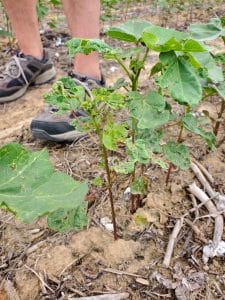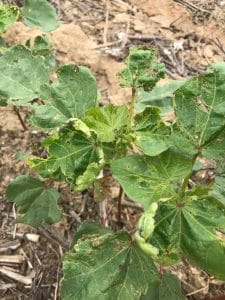As scouting of cotton continues there are some diseases to be on the look out for…
Leaf Spots
Bacterial pathogen –bacterial blight leaf symptoms can be seen on leaves and possibly bolls later in the season. Bacterial blight is caused by the bacteria Xanthomonas citri pv malvacearum and hence will not respond to a fungicide. Typical symptoms are water-soaked spots that turn black as they expand and may follow veins, as atypical symptoms may look like target spots but with yellow halos (image 1-2). Similarly, symptoms on bolls are water-soaked, sunken lesions (image 3). Defoliation may occur. Planting resistant varieties is the main management option.
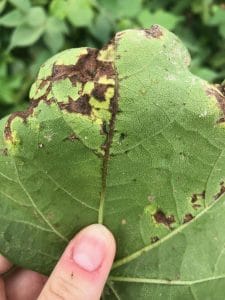
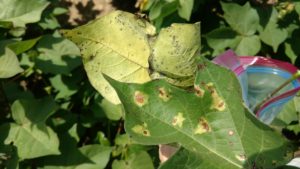
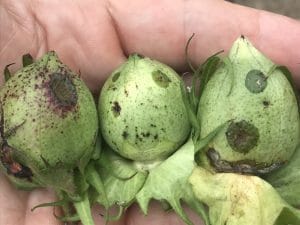
Fungal pathogens – The usual foliar spotting has been seen: leaf spot complex (stemphyllium, Cercospora, and Alternaria) – image 4, and target spot – image 5. While the leaf spot complex is usually associated with nutrient deficiency or other stressor, it will not respond to a foliar fungicide (i.e. yield will be the same with or without a fungicide). On the other hand, target spot can require a foliar fungicide to reduce defoliation and protect yield. The main way to know the difference between the 2 leaf spots are where they are located in the field and canopy. Target spot lesions will start in the lower canopy in the rankest/growthiest cotton areas – usually only effecting high yielding cotton. Leaf spot complex lesions will be throughout the canopy and might be concentrated in areas of the field of low potash.
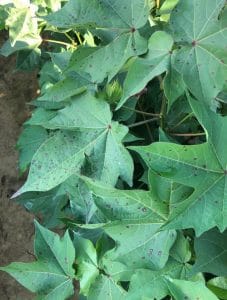
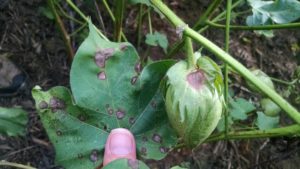
Times that fungicide applications are beneficial to protect from target spot depend on variety susceptibility, disease pressure, and environmental conditions (back to the factors that influence when a disease becomes a PEST – Pathogen presence, Environment, Susceptible host, and Timing – growth stage and calendar date). When a fungicide application is warranted, the timing that has had the best probability of decreasing defoliation and protecting yield in TN has been 3rd week of bloom to 5th week of bloom (~7 NAWF to 5 NAWF).
See guide.utcrops.com for more images, information, and a diagnostic key to differentiating leaf spots in cotton.
Wilts
Verticillium wilt, caused by the soilborne fungus Verticillium dahlia, can be found across TN cotton fields. While the wilting symptoms can be seen on relatively young plants, it’s usually after flowering when most of the foliar symptoms and vascular discoloration are seen (images 6). Management options include using partially resistant or tolerant varieties and manipulation of cultural practices such as seeding rate, irrigation level or crop rotation.
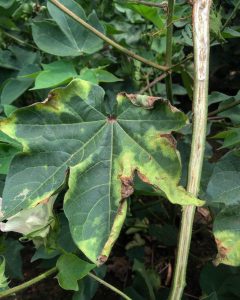
Virus
The newest pathogen in cotton is the Cotton leafroll dwarf virus (CLRDV) vectored by the cotton aphid, that can cause cotton blue disease. First reported in AL in 2017 and since found in TN, the virus is established in Brazil. Symptoms observed in includes stunting, upward-cupped leaves, and general distorted growth/crinkled leaves (images 7-8). Although fields are known to grow out of these symptoms and one would not perceive anything to be out of the ordinary. So far we have not observed any yield loss due to the virus in TN. More information about the virus can be found in the Auburn extension fact sheet on Cotton Blue Disease (ANR-2539). As of now, no changes in management practices are recommended.
